Research - Journal of Drug and Alcohol Research ( 2024) Volume 13, Issue 8
Medication Adherence and Quality of Life among Cardiology Patients in Guntur.
Nutakki Tulasi Uma Rani1*, Dinesh Kumar Upadhaya1 and Rajesh Akki22Department of Pharmaceutics, Hindu College of Pharmacy, India
Nutakki Tulasi Uma Rani, Department of Pharmacology, School of Pharmaceutical Sciences, Jaipur National University, India, Email: nturani35@gmail.com
Received: 31-Jul-2024, Manuscript No. JDAR-24-128024; Editor assigned: 02-Aug-2024, Pre QC No. JDAR-24-128024 (PQ); Reviewed: 16-Aug-2024, QC No. JDAR-24-128024; Revised: 21-Aug-2024, Manuscript No. JDAR-24-128024 (R); Published: 28-Aug-2024, DOI: 10.4303/JDAR/236405
Abstract
To determine the levels of Medication adherence and Quality of life among patients with Cardiovascular Diseases (CVD). A prospective observational design was used to conduct this study. A total of 1158 patients with CVDs are recruited in the study who visits the cardiology departments in Guntur. Data were collected using Medication Adherence Rating Scale (MARS) and Short Form-36. The level of medication adherence among the patients, 73.2% were reporting high adherence, 14.8% were medium adherence and 12% were low adherent medication. Quality of Life (QOL) analysis by SF-36 shows significant effect in social functioning, pain and emotional wellbeing. Highest medication adherence was observed among the patients with CVDs. Factors effecting the quality of life social functioning, pain and emotional wellbeing in CVD patients.
Keywords
Medication adherence; QoL; MARS; SF-36
Introduction
Around the world, heart disease is rising to the top of the list of causes of death [1]. The leading cause of illness and mortality, accounting for around 18 million deaths globally each year, is cardiovascular disease [2]. The prevalence of cardiovascular disease is increasing drastically in countries like China, India, Pakistan and the Middle East, including Iran [3]. In developed nations; the United States, Europe and Japan have the highest, moderate and lowest rates of cardiovascular disease [4-6]. People with cardiovascular disease may experience a poor quality of life due to various physical and emotional symptoms, which can limit their daily activities and lead to high hospitalization and mortality rates.
Although treatment for cardiovascular disease have considerably improved over the past 50 years, patient adherence remains suboptimal with approximately 50% of patients failing to follow prescriptions [7,8]. In general, cardiac patients do not adhere to their treatments due to long term medication [9]. Previous literature indicates that medication adherence rates in chronic disease patients range between 40%-50% [10]. Medication adherence is crucial for patients with cardiovascular diseases as it directly impacts the effectiveness of treatment and clinical outcomes.
Medication adherence is defined as follows by the WHO: “Adherence is defined as the extent to which a person follows healthcare provider recommendations for medication, diet and lifestyles” [11].
CVD can reduce quality of life and shorten life span in advanced stages of the disease; even it is silent at first. The term Quality of Life was initially associated with health and functional status. However, it now encompasses people’s current values, objectives, standards, and interests all are part of their comprehension of life. Quality Of Life (QOL) is a critical component of healthcare quality, as evidenced by numerous studies [12-14].
WHO defines “Quality of Life as individual’s perceptions of their position in life in relation to their goals, expectations, standards and concerns, which can be determined by Physical, Psychological, Social and Environmental aspects” [15].
Patients frequently struggle with medication adherence for cardiovascular conditions, which can have a negative impact on their health and quality of life. Emphasizing the importance of adherence in improving treatment outcomes. The knowledge about quality of life and medication adherence of people in Guntur with cardiovascular disease.
Materials and Methods
A data collecting form has been prepared with the necessary information for the study. This covers patient demographics, religion, marital status, social habits, profession, education status, and any co-morbid problems they are suffering; it includes treatment chart information, prescribed medications and therapy changes. MARS and SF-36 are used in the study to measure medication adherence and quality of life.
MARS (Medication Adherence Rating Scale)
MARS 10-itemself report instrument that asks questions and responds with a yes or no.0 is coded for nonadherence; 1 is coded for adherence. No response for the questions 1-6 and 9-10 are coded with 1 which indicates adherence; yes response to the questions 7 and 8 are coded with 1 which indicates adherence here. We have assigned the score to each patient based on their responses to the MARS questionnaire during their visits. The total score range between 0 (low medication adherence) and 10 (high medication adherence).
Score 0-3=Non adherence
Score 4-6=Moderate adherence
Score 7-10=Adherence
Short-form health survey (SF-36): SF-36 questionnaire consists of 36 questions divided into 8 domains. PFphysical functioning, RP-role limitations due to physical health problems, BP-bodily pain, GH-general health, VTvitality (energy and fatigue), SF-social functioning, RErole limitations due to emotional problems and MH-mental health. The domains can be classified into 2 summary scales:
1. Physical Component Summary (PCS): It comprises PF, RP, BP, and GH
2. Mental Component Summary (MCS): It comprises RE, SF, MH and VT domains.
Statistical analysis
All the raw data collected, recorded in data collection form was updated in sheets of Microsoft Office Excel 2007 and statistically analysis was done by using SPSS version 28.
Sequence of study
Patients were educated about the study’s aims, data requirements, confidentiality, subject rights, and duties in layman language. Written informed permission was obtained. Initially, all patients were evaluated, and those who met the requirements were enrolled in the research. Data was collected and analyzed subsequently.
Results
Gender distribution
The study involved 1158 participants, consisting of 732 males and 426 females. This finding shows that males were approximately 26% more susceptible to cardiovascular events compared to female, (Table 1) (Figure 1).
Table 1: Gender distribution
| Gender | Subjects | Percentage |
|---|---|---|
| Male | 732 | 63.21 |
| Female | 426 | 36.79 |
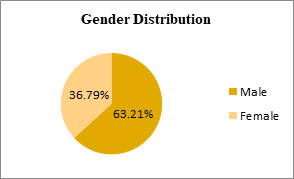
Figure 1: Gender distribution
Age distribution
Majority of the patients belonged to 61 years-70 years of age, later occupies 51 years-60 years of age. As the percentages do not differ much, we conclude that 51 years to 70 years old has a high incidence of cardiovascular events. Very few patients are under the age of 40 years old (Table 2) (Figure 2).
Table 2: Age distribution
| Age group | No. of persons | Percentage |
|---|---|---|
| <40 | 32 | 2.8 |
| 40-50 | 148 | 12.8 |
| 51-60 | 376 | 32.5 |
| 61-70 | 458 | 39.6 |
| 71-80 | 114 | 12.4 |
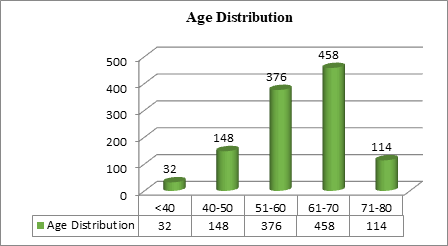
Figure 2: Age distribution
Religion
Among 1158 patients, 69.3%Hindus having the highest incidence of CVD, 16.8% Muslims having CVD, 13.9% Christians having CVD & others with no CVD (Table 3) (Figure 3).
Table 3: Religion distribution
| Religion | No. of patients | Percentage |
|---|---|---|
| Hindu | 803 | 69.3 |
| Muslim | 194 | 16.8 |
| Christians | 161 | 13.9 |
| Others | 0 | 0.0 |
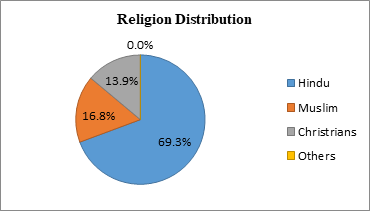
Figure 3: Religion distribution
Marital status
Highest incidences of CVD are observed in married patients with 88.3%, 11.4% in single/widow and 0.3% unmarried with least CVD (Table 4) (Figure 4).
Table 4: Patient marital status
| Patient marital status | No. of patients | Percentage |
|---|---|---|
| Married | 1023 | 88.3 |
| Unmarried | 03 | 0.3 |
| Single/widow | 132 | 11.4 |
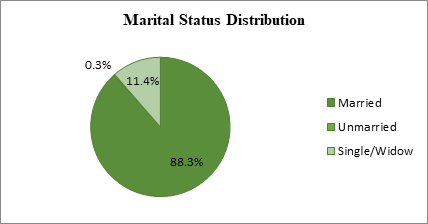
Figure 4: Marital status distribution
Education
53.5% were considered literate because 27.2% had qualified for SSC (10th class), 10.6% had discontinued education after Inter, 9.6% had completed their degree and the remaining 5.8% had postgraduate or higher education. 46.4% were illiterate (Table 5) (Figure 5).
Table 5: Education
| Education | No. of patients | Percentage |
|---|---|---|
| No schooling | 538 | 46.4 |
| 10th class | 316 | 27.2 |
| Inter | 123 | 10.6 |
| Degree | 114 | 9.8 |
| PG and higher | 67 | 5.7 |
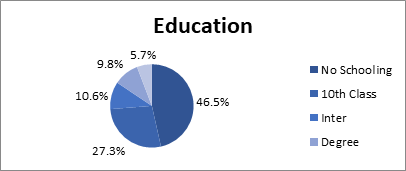
Figure 5: Education
Occupation
The majority of the patients 33.2% were daily wages, we included farmers in this category as well. Next, 23.6% of patients were house wives (females).19.1% owned their own businesses in a variety of fields. 8.2% of members worked in either the private or public sectors 15.9% were retired employees, some of them are pensioners and others who are not (Table 6) (Figure 6).
Table 6: Occupation
| Occupation | No. of patients | Percentage |
|---|---|---|
| Daily wages | 385 | 33.2 |
| Business | 221 | 19.1 |
| Job holder | 95 | 8.2 |
| House wife | 273 | 23.6 |
| Retried | 184 | 15.9 |
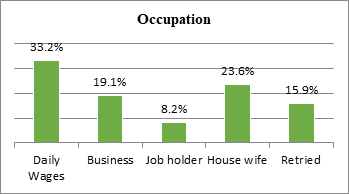
Figure 6: Occupation
Social habits
One of the most significant risk factors for various diseases or disorders is one’s social habits. 36.4% of the patients use tobacco, either in chewable form or by smoking. 29.5% of patients do not have any habits such as smoking, tobacco use, or alcohol consumption. 9.4% are only alcoholics, they do not smoke or consume tobacco, the majority are daily consumers, with the remainder consuming on weekends and special occasions. 24.7% of the population is both an alcoholic and a smoker (Table 7) (Figure 7).
Table 7: Social habits
| Social habits | No. of patients | Percentage |
| Smoker/tobacco | 421 | 36.4 |
| Alcoholic | 109 | 9.4 |
| Both | 286 | 24.7 |
| None | 342 | 29.5 |
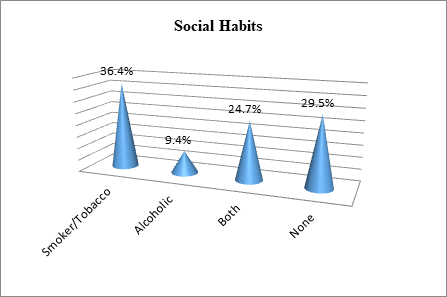
Figure 7: Social habits
Co-morbidities
The majority of the patients had both hypertension and diabetes mellitus, with 35.6% having the highest incidence. 31.8% had coronary artery disease. 13.5% had hypertension (which includes arrhythmia, heart failure and left ventricular disease among other things). 12.4% had Dilated cardiomyopathy, 6.7% had myocardial infarction, the least common cardiovascular event (Table 8) (Figure 8).
Table 8: Co-morbidities
| Co-morbidities | No. of patients | Percentage |
|---|---|---|
| CAD | 368 | 31.8 |
| HTN | 156 | 13.5 |
| DCMP | 144 | 12.4 |
| HTN and DM | 412 | 35.6 |
| MI | 78 | 6.7 |
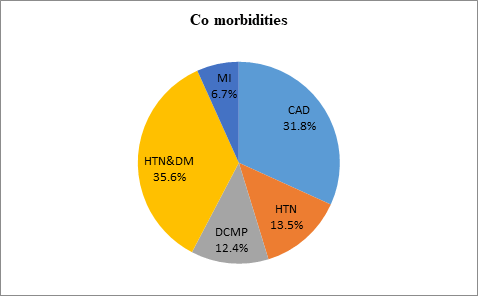
Figure 8: Co-morbidities
Prescribing pattern
1158 patients were included in the study, and the doctors either continued to prescribe the same medication or made little adjustments. Some patients changed to more potent treatment combinations, while others stuck with their original regimen. As, a result we considered each visit to be a new prescription. Therefore, 1158 × 4 visits=4632 Total number of prescriptions.
Dual therapy was highly prescribed (41.01%) among the 4632 prescriptions because its effectiveness and treatment outcome are superior to single drug therapy, which was provided in 34.5% of prescriptions. Dual therapy is generally preferred in patients who have not been able to reduce their high blood pressure to therapeutic levels.
Triple therapy was prescribed in 19.2% of prescriptions. 4.3% of prescriptions were of quadruple therapy, while only 0.86% was for penta therapy. Patients with severe illnesses were given quadruple and penta therapy. The type of therapy varies depending on the severity and the combination preferred depends on the patient’s condition (Table 9) (Figure 9).
Table 9: Types of therapy prescribed
| Types of therapy | Total no. of prescriptions | Percentage |
|---|---|---|
| Monotherapy | 1600 | 34.5 |
| Dual therapy | 1900 | 41.01 |
| Triple therapy | 892 | 19.2 |
| Quadruple therapy | 200 | 4.3 |
| Penta therapy | 40 | 0.86 |
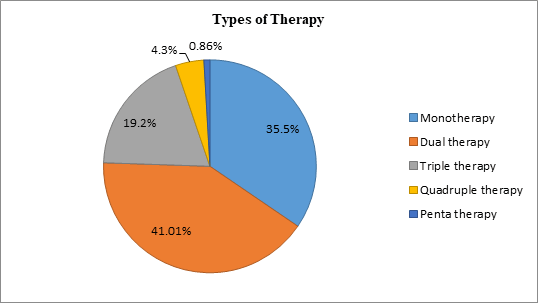
Figure 9: Types of therapy prescribed
Medication adherence
For a successful treatment medication adherence plays a crucial role. For each hospital visit, we recorded the patient’s medication adherence score. So, that we can assess changes in adherence and counsel them appropriately. Approximately half of the patients were initially adherent to the medication during their first visit (49.9% were highly adherent), 23.3% were medium adherent and 27.1 were low adherent. We counselled all of the patients on medication use, the benefits of adhering to medications, and ideas for overcoming non-adherence which had increased in patients adhering to medication. Patients with high adherence increased gradually, while those with medium and low adherence decreased gradually. Some patients who were previously low adherence have improved to a medium level of adherence. During the fourth visit, we observed that 73.2% were highly adherent, 14.8% were medium adherent and 12% were low adherent (Table 10) (Figure 10).
Table 10: Medication adherence
| Adherence | Initial (Visit I) | Visit II | Visit III | Visit IV | ||||
|---|---|---|---|---|---|---|---|---|
| No. of patients | Percentage | No. of patients | Percentage | No. of patients | Percentage | No. of patients | Percentage | |
| High | 578 | 49.9 | 634 | 54.7 | 722 | 62.3 | 848 | 73.2 |
| Medium | 266 | 23.0 | 228 | 19.7 | 258 | 22.3 | 171 | 14.8 |
| Low | 314 | 27.1 | 296 | 25.6 | 178 | 15.4 | 139 | 12.0 |
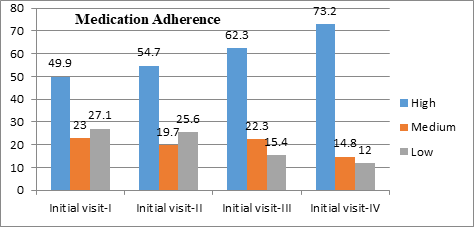
Figure 10: Medication adherence
Quality of life
To measure quality of life, short from 36 was used. A significant difference was observed in Pain, Emotional wellbeing and social functioning. The study found no significant differences in physical functioning, limitations due to physical health, emotional problems, energy fatigue, and general health between male and female patients.
The summary scales of the 2 domains are compared, physical component summary where males are higher in all domains (PF, RP, BP, GH) than females, in mental component summary where females are faintly higher in all domains (RE, SF, VT except MH) than male (Tables 11 and 12).
Table 11: SF 36
| Question | Male | Female | ||
|---|---|---|---|---|
| Mean | SD | Mean | SD | |
| Physical functioning | 76.35 | 21.23 | 75 | 20.68 |
| Limitations due to physical health | 73.75 | 35.33 | 72.1 | 22.1 |
| Emotional problems | 62.16 | 44.56 | 65.83 | 41.68 |
| Vitality (energy and fatigue) | 56.25 | 16.67 | 57.13 | 23.86 |
| Emotional well-being (mental health) | 64.65 | 24.32 | 59.78 | 17.51 |
| Social functioning | 64.25 | 29.31 | 68.5 | 20.58 |
| Pain | 59.73 | 20.68 | 72.01 | 22.1 |
| General health | 73.5 | 20.58 | 75.9 | 16.42 |
Table 12: Summary scales of the 2 domains PCS AND MCS
| Physical Component Summary | Mental Component Summary | ||||
|---|---|---|---|---|---|
| Domains | Male | Female | Domains | Male | Female |
| Mean (SD) | Mean (SD) | Mean (SD) | Mean (SD) | ||
| Physical Functioning (PF) | 76.35 (21.23) | 75 (20.68) | Role limitations due to emotional problems (RE) | 62.16 (44.56) | 65.83 (41.68) |
| Role limitations due to physical health problems (RE) | 73.75 (35.33) | 72.1 (22.1) | Social Functioning (SF) | 64.25 (29.31) | 68.5 (20.58) |
| Bodily Pain (BP) | 59.73 (20.68) | 72.01 (22.1) | Vitality (energy and fatigue) (VT) | 56.25 (16.67) | 57.13 (23.86) |
| General Health (GH) | 73.5 (20.58) | 75.9 (16.42) | Emotional well-being (Mental Health) (MH) | 64.65 (24.32) | 59.78 (17.51) |
Discussion
Cardiovascular disease is a chronic condition that need ongoing medication. CVD therapy is hampered by poor adherence and lifestyle factors. CVD treatment aims to enhance patient quality of life, which is a developing area of focus and has a significant chronic illness outcome.
Previous studies have shown that nearly 50% of patients do not adhere to their prescribed medications, leading to suboptimal therapeutic effects and negative health outcomes.
The present study evaluated adherence to cardiovascular medication and quality of life among cardiovascular diseases patients. Medication adherence is crucial as it directly impacts illness outcomes.
According to our study, the overall medication adherence was observed as high adherence 73.2%, medium adherence 14.8% and low adherence 12.0%. According to Qazi Kamran et al. (2023), the low adherence rate was observed to be 57.1%, which is very high when compared to the observations of our study [16].
Our study has revealed adherence rate was increased by 25.3%, moderate adherence rate decreased by 8.2% and low adherence rate decreased by 12.63%, Our study is in consistent with the study Sabu et al. (2016) where the adherence rate increased by 23.3%, low adherence rate decreased by 12.63%, but moderate adherence rate decreased by 25.3%, in our study it was decreased by 8.2% [17].
In 2022 study conducted in India among patients with hypertension, congestive heart failure and ischemic heart disease exhibited drug adherence as following 20.83%, 28.37% and 32% respectively [18]. Another study of 280 patients in rural India found that 32% of the patients shoed poor adherence to the treatment [19].
About 56% of the patients in Mallya SD et al. (2016) had education upto the 12th or 10+2 standard. Our study is in the similar line with 53.5% which might explain their high adherence rate [20].
This study revealed highest QoL score for male in Physical functioning (76.35) and female in General health (75.9); but lowest QoL score is same for both male and female in energy fatigue (56.25 and 57.13). In PCS domain significant difference was observed in pain, highest in women and in MCS domain significant difference was observed in Mental health (emotional wellbeing), highest in men.
Our results showed that there was no significant difference in quality of life between men and women. Our finding is in accordance with the studies done by Chatzinikolaou et al. (2021) [21]. Our observation contradicts previous research that suggested women often had lower quality of life than men.
According to our study, women had a higher QoL score on the pain, compared to male. Our results contradicted previous study done by Chatzinikolaou et al. (2021) that suggested men had a higher QoL score on the pain [21].
Conclusion
This study found that 73.2% of participants in the study were adherent to their medication. The study confirms that patients with CVD in Guntur experience significant impacts on the quality of life including pain, social functioning and mental health. More research is needed to enhance the adherence and quality of life of cardiovascular patients, which can help health care professionals to improve patient care.
Acknowledgement
None.
Funding
None.
Conflict Of Interest
The author declares no conflict of interest.
References
- S. Azami-Aghdash, H. Gharaee, M.H. Aghaei, N. Derakhshani, Cardiovascular disease patient's quality of life in Tabriz City in Iran in 2018, J Comm Health Res, 8(2019):245-252.
- D.A. Gonzalez-Chica, E. Dal Grande, J. Bowden, M. Musker, P. Hay, et al. Are we reducing the risk of cardiovascular disease and improving the quality of life through preventive health care? Results of a population-based study in South Australia, Prev Med, 99(2017):164-170
- K.S. Reddy, Cardiovascular disease in Non-Western countries, N Engl J Med, 350(2004):2438-2440.
- A. Mohammadzadeh, A. Amini, R.A. Hamid, M.M. Ahmadi, S. Ghaffaripoor, Cardiopulmonary arrest outcome in Nemazee Hospital, southern Iran, Iran Red Crescent Med J,(2009):11(4): 437-441.
- H. Ashraf, A. Rashidi, S. Noshad, O. Khalilzadeh, A. Esteghamati, Epidemiology and risk factors of the cardio metabolic syndrome in the Middle East, Exp Rev Cardiovascular Therapy, 9(2011):309-320.
- Z. Vojvodic, D. Stimac, Trends in statin consumption and cardiovascular mortality in Croatia 2004-2012, Coll Antropol, 2(2014):73-8.
- E. Sabate, Adherence to long term therapies, evidence for action, Geneve, Switzerland: WHO, 2003.
- I.M. Kronish, S. Ye, Adherence to cardiovascular medications: Lessons learned and future directions, Prog Cardiovasc Dis, 5(2013):590-600.
- A. Salari, L.R. Balasi, A. Ashouri, F. Moaddab, F. Zaersabet, et al. Medication adherence and its related factors in patients undergoing coronary artery angioplasty, J Caring Sci, 7(2018):213.
- M.T. Brown, J.K. Bussell, Medication adherence: WHO cares? Mayo Clin Proc, (2011):86:304â??314.
- World Health Organization, Hypertension in adherence to long-term therapies-evidence for action, 2003.
- M. Najafi, M. Sheikhvatan, A. Montazeri, S.H. Abbasi, M.S. Fatollahi, Quality of life in coronary artery disease: SF-36 compared to WHOQOL-BREF, JTHC, 3(2008):101-6.
- Z.N. Hatmi, M.S.M.A. Kazemi, Quality of life in patients hospitalized with heart failure: A novel two questionnaire study, Acta Medica Iranica, (2007):45(6):493-500.
- H.R. Taghipour, M.H. Naseri, R. Safiarian, Y. Dadjoo, B. Pishgoo, et al. Quality of life one year after coronary artery bypass graft surgery, Iran Red Crescent Med J, (2011) :13(3):171-177.
- World Health Organization, WHOQOL-BREF introduction, administration, scoring and generic version of assessment, program on mental health, Geneva, Switzerland, 1996.
- A. Saeed, Q.K. Amin, R. Saeed, Z.A. Yousafzai, Comparing medication non-adherence in cardiovascular disease patients at public and private hospitals in Peshawar: A cross-sectional study of prevalence and contributing factors, Cureus, 15(2023):e36345.
- A.B. Johnson, A. Sebastian, A. Sudulaguntla, A.C. Sabu, S. Meka, et al. Medication adherence ratting of patients with hypertension in a tertiary care hospital, World J Pharmacy Pharmaceutical Sci, 5(2016):694-710.
- Y. Krishnamoorthy, S. Rajaa, T. Rehman, M. Thulasingam, Patient and provider's perspective on barriers and facilitators for medication adherence among adult patients with cardiovascular diseases and diabetes mellitus in India: A qualitative evidence synthesis, BMJ Open, (2022):2:e055226.
- G. Santra, Assessment of adherence to cardiovascular medicines in rural population: An observational study in patients attending a tertiary care hospital, Ind J Pharmacol, (2015):47:600-604.
- S.D. Mallya, A. Kumar, A. Kamath, A. Shetty, S.K.T. Reddy, et al. Assessment of treatment adherence among hypertensive patients in coastal area of Karnataka, India, Int J Community Med Public Health, 3(2016) :1998-2003.
- A. Chatzinikolaou, S. Tzikas, M. Lavdaniti, Assessment of quality of life in patients With cardiovascular disease using the SF36, mac new, and EQ-5D-5L questionnaires, Cureus, 13(2021):e17982
Copyright: © 2024 Nutakki Tulasi Uma Rani, et al. This is an open access article distributed under the terms of the Creative Commons Attribution License, which permits unrestricted use, distribution, and reproduction in any medium, provided the original work is properly cited.

